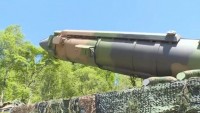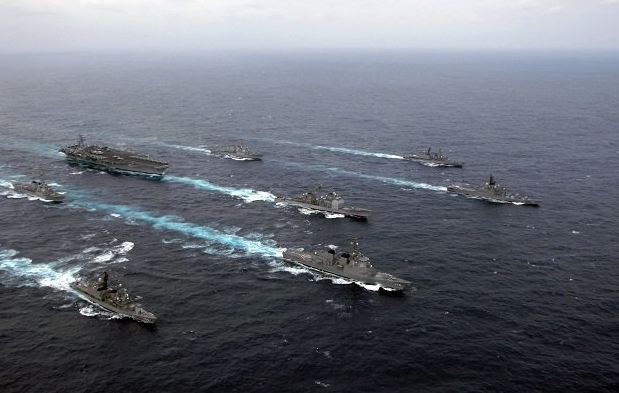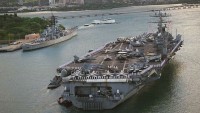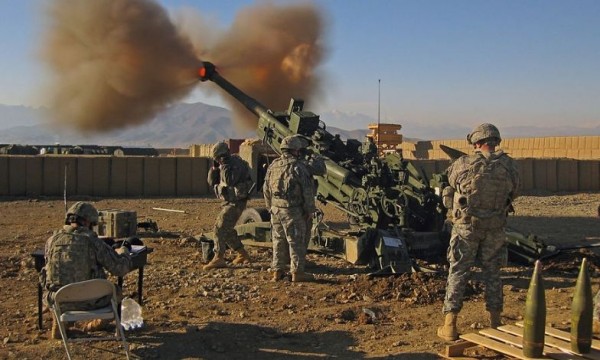US Forges Ahead with Plans to Deploy Land-based Artillery to South China Sea Islands
| Arthur Dominic Villasanta | | Jan 03, 2017 09:31 PM EST |
(Photo : US Army) M777 firing
The United States will continue its "freedom of navigation operations" (FONOPS) in the South China Sea and will deploy more offensive and defensive weapons on islets or reefs held by its allies in the disputed sea.
The loss of the Philippines as an ally due to the pro-communist leanings of president Rodrigo Duterte means the U.S. is left with Vietnam and the Republic of China (Taiwan). Of these countries, Vietnam might likely be more receptive while Taiwan will reject it outright.
Like Us on Facebook
Which might leave the U.S. the option of building its own islands in the South China Sea.
As the U.S. ponders its options, the U.S. Army is continuing plans it made in 2016 to deploy its long-range artillery howitzers to friendly islands in the South China Sea. In essence, a new type of ammunition will transform army howitzers and navy cannons into anti-aircraft guns capable of shooting down enemy missiles.
The army and the U.S. Navy are undertaking coordinated programs to allow their existing artillery systems to fire the new hypervelocity projectiles (HVPs) designed originally for electromagnetic railguns as missile-killing ammunition for its conventional naval guns and ground artillery systems.
Studies by the Department of Defense have revealed HVPs fired from 5 inch (127 mm) Mk-45 guns aboard U.S. Navy warships such as the Arleigh Burke-class guided missile destroyers, and the 155 mm guns aboard the Zumwalt-class destroyers can neutralize anti-ship missile (AShM) salvoes.
AShMs will be the chosen mode of attack by China and Russia against U.S. Navy warships, especially aircraft carriers, in any future conflict.
DoD believes "if we can close the fire support with a controlled solution," HVPs will be able to shoot down most of the missiles in a 100 AShM attack.
When fired from conventional 5 inch guns, HVPs achieve a speed of Mach 3 (3,700 km/h), half the speed it achieves when fired from a railgun, but more than twice the speed of a conventional high-explosive round.
A project of the Office of Naval Research (ONR), HVP is a next-generation, common, low drag, guided projectile for gun systems such as the Navy 5 inch, 155 mm and future railguns.
HVP's low drag aerodynamic design enables high-velocity, maneuverability and decreased time-to-target. The high-velocity compact design relieves the need for a rocket motor to extend gun range.
The U.S. Army plans similar tests of the HVP with its 155 mm M109A6 Paladin self-propelled howitzers and its M777 155 mm Ultra-Light Towed Howitzers.
Firing smaller more accurate rounds improves danger close/collateral damage requirements and provides potential for deeper magazines and improved shipboard safety. The modular design will allow HVP to be configured for multiple gun systems and to address different missions.
HVP is being designed to provide lethality and performance enhancements to current and future gun systems.
The M777 and the Paladin can be used as a mobile, direct countermeasures to incoming rockets. A key advantage to using a Paladin is that it's a mobile platform that can better adjust to fast-changing, incoming enemy fire.
TagsUnited States, freedom of navigation operations, hypervelocity projectiles, U.S. Army, South China Sea, M109A6 Paladin self-propelled howitzer, M777 155 mm Ultra-Light Towed Howitzer
©2015 Chinatopix All rights reserved. Do not reproduce without permission
 China Warns of World War III if Sea Battles Erupt in South China Sea
China Warns of World War III if Sea Battles Erupt in South China Sea China Almost Began a War against the United States in July over South China Sea
China Almost Began a War against the United States in July over South China Sea US Navy Deploys USS Carl Vinson Strike Group to Asia; Over 100 Fighter Jets Ready for War
US Navy Deploys USS Carl Vinson Strike Group to Asia; Over 100 Fighter Jets Ready for War Putin Claims Russia has the Most Powerful Armed Forces on Earth
Putin Claims Russia has the Most Powerful Armed Forces on Earth
EDITOR'S PICKS
-

Did the Trump administration just announce plans for a trade war with ‘hostile’ China and Russia?
-

US Senate passes Taiwan travel bill slammed by China
-

As Yan Sihong’s family grieves, here are other Chinese students who went missing abroad. Some have never been found
-

Beijing blasts Western critics who ‘smear China’ with the term sharp power
-

China Envoy Seeks to Defuse Tensions With U.S. as a Trade War Brews
-

Singapore's Deputy PM Provides Bitcoin Vote of Confidence Amid China's Blanket Bans
-

China warns investors over risks in overseas virtual currency trading
-

Chinese government most trustworthy: survey
-

Kashima Antlers On Course For Back-To-Back Titles
MOST POPULAR
LATEST NEWS
Zhou Yongkang: China's Former Security Chief Sentenced to Life in Prison

China's former Chief of the Ministry of Public Security, Zhou Yongkang, has been given a life sentence after he was found guilty of abusing his office, bribery and deliberately ... Full Article
TRENDING STORY

China Pork Prices Expected to Stabilize As The Supplies Recover

Elephone P9000 Smartphone is now on Sale on Amazon India

There's a Big Chance Cliffhangers Won't Still Be Resolved When Grey's Anatomy Season 13 Returns

Supreme Court Ruled on Samsung vs Apple Dispute for Patent Infringement

Microsoft Surface Pro 5 Rumors and Release Date: What is the Latest?










